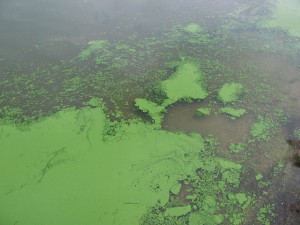Algal blooms in Lake Erie will continue without decreased fertilizer runoff
 Photo Credit: Dr. Jennifer L. Graham | U.S. Geological Survey
Photo Credit: Dr. Jennifer L. Graham | U.S. Geological Survey
A recent study published in the Proceedings of the National Academy of Sciences sheds some light on the record-breaking algal bloom observed in Lake Erie in 2011, and makes some frightening predictions for the future. The research, led by Dr. Anna Michalak of the Carnegie Institute for Science, shows that phosphorus-laden fertilizer runoff from conventional agricultural operations played an integral part of the bloom. The nutrient runoff combined with weak currents and calm winds to provide the perfect environment for algal formation, resulting in high levels of toxins hundreds of times higher than levels approved by the World Health Organization for drinking and recreational waters.
Unfortunately, if conventional agricultural practices continue as they are today, this type of algal bloom could be a regular event in the Great Lakes region. “If a scientifically guided management plan to mitigate these impacts is not implemented, we can therefore expect this bloom to be a harbinger of future blooms in Lake Erie,” states the report. Decreasing the use of fertilizers in agriculture will be key for maintaining the health of the Great Lakes and those who live around them.



